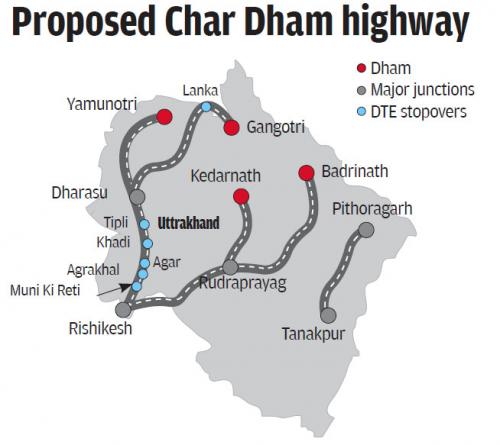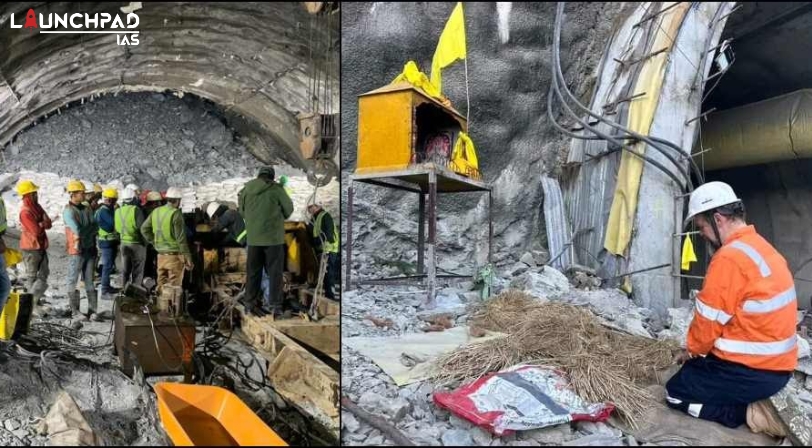Recently an under-construction Silkyara-Barkot Tunnel in Uttarkashi District, Uttarakhand collapsed. This trapped 41 workers inside.
Silkyara-Barkot Tunnel is part of Chaar Dham’s all-weather road project. The construction of the tunnel was carried out by Navayuga Engineering Company. It is owned by the Ministry of Road Transport and Highways, Government of India.

Possible Causes of Tunnel Collapse
- Fractured Rock: There might be a hidden patch of Fractured or Weak rock, undetectable during construction. Water seepage through this compromised rock could have eroded it over time, creating an unseen void atop the tunnel structure.
- Design Error: Every long tunnel should have a backup exit, which was missing in this tunnel’s design.
- Fragile Ecosystem: The recent tunnel collapse incident raises concerns regarding the feasibility of heavy construction in the delicate Himalayan ecosystem.
Tunnel Excavation Techniques:
- Drill and Blast Method (DBM): Involves drilling holes into rock and detonating explosives to break it apart.
- DBM is often used in regions like the Himalayas (Jammu & Kashmir and Uttarakhand) due to the challenging terrain.
- Tunnel-Boring Machines (TBMs): They bore through rock while supporting the tunnel behind with precast concrete segments. It is a more expensive but safer method.
- TBMs are ideal when the rock cover is up to 400 metres tall. Underground tunnels for the Delhi Metro were dug using a TBM at shallow depth.
Steps that should be taken to avoid such mishaps in the future
- Adhering to International Standards: While drilling rocks in the Himalayan Ecosystem, we should stick to international standards. According to international standards, there should always be backup exits in tunnels of such length.
- Risk Assessment and Preparedness:
- Conducting third-party risk assessment periodically, considering geological, environmental, and usage factors.
- Developing contingency plans and emergency protocols in case of any structural concerns
- Technology Integration: Explore innovative technology like Artificial Intelligence, Drones, or robotics for more efficient inspection, maintenance, and early detection of potential issues
Other Major Tunnels in India
- Atal Tunnel (Rohtang Tunnel): Located under the Rohtang Pass in the eastern Pir Panjal range of the Himalayas on the Leh-Manali Highway in Himachal Pradesh, the Atal Tunnel, also known as Rohtang Tunnel, holds the record as the world’s longest tunnel above 10,000 feet (3,048 m), with a length of 9.02 km.
- Pir Panjal Railway Tunnel: Extending over 11.2 km, the Pir Panjal Railway Tunnel is India’s lengthiest transportation railway tunnel. It traverses the Pir Panjal mountain range, connecting Quazigund and Baramulla.
- Jawahar Tunnel (Banihal Tunnel): Also known as Banihal Tunnel, Jawahar Tunnel spans a length of 2.85 km. This tunnel ensures year-round road connectivity between Srinagar and Jammu.
- Dr Syama Prasad Mookerjee Road Tunnel (Chenani-Nashri Tunnel): Formerly referred to as the Chenani-Nashri Tunnel, this road tunnel is India’s lengthiest, measuring 9.3 km. Now known as Dr Syama Prasad Mookerjee Road Tunnel, it plays a crucial role in enhancing road connectivity.
Visit Our Website for more such Informative Blogs!


